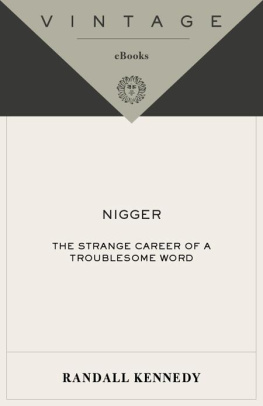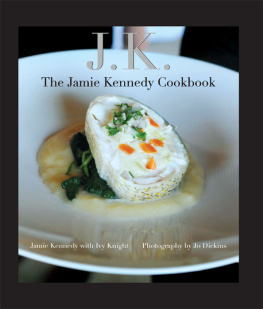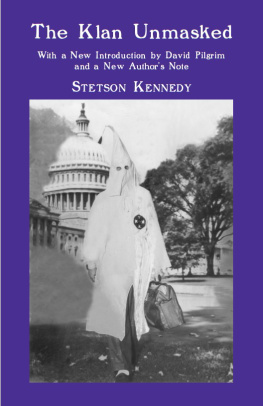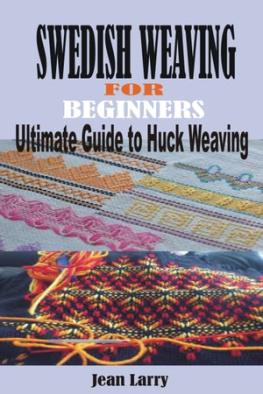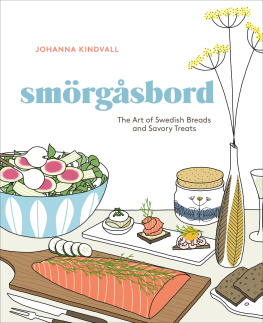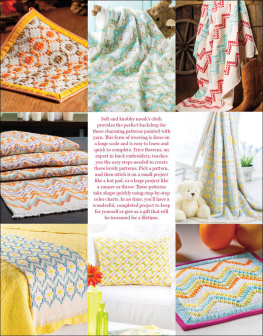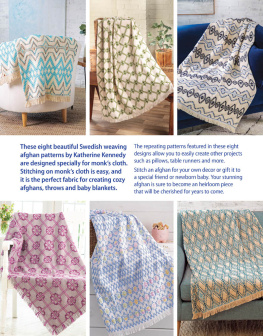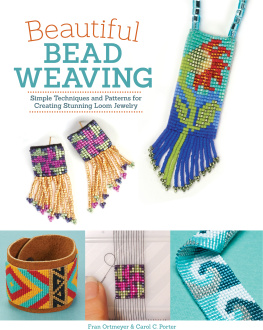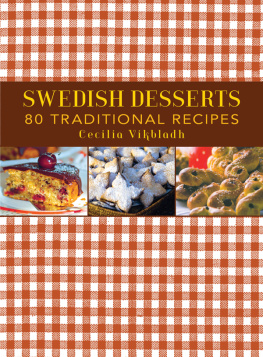Kennedy - Learn Swedish Weaving & Huck Embroidery
Here you can read online Kennedy - Learn Swedish Weaving & Huck Embroidery full text of the book (entire story) in english for free. Download pdf and epub, get meaning, cover and reviews about this ebook. City: Sweden, year: 2014, publisher: Annies, genre: Home and family. Description of the work, (preface) as well as reviews are available. Best literature library LitArk.com created for fans of good reading and offers a wide selection of genres:
Romance novel
Science fiction
Adventure
Detective
Science
History
Home and family
Prose
Art
Politics
Computer
Non-fiction
Religion
Business
Children
Humor
Choose a favorite category and find really read worthwhile books. Enjoy immersion in the world of imagination, feel the emotions of the characters or learn something new for yourself, make an fascinating discovery.
- Book:Learn Swedish Weaving & Huck Embroidery
- Author:
- Publisher:Annies
- Genre:
- Year:2014
- City:Sweden
- Rating:5 / 5
- Favourites:Add to favourites
- Your mark:
- 100
- 1
- 2
- 3
- 4
- 5
Learn Swedish Weaving & Huck Embroidery: summary, description and annotation
We offer to read an annotation, description, summary or preface (depends on what the author of the book "Learn Swedish Weaving & Huck Embroidery" wrote himself). If you haven't found the necessary information about the book — write in the comments, we will try to find it.
Learn Swedish Weaving & Huck Embroidery — read online for free the complete book (whole text) full work
Below is the text of the book, divided by pages. System saving the place of the last page read, allows you to conveniently read the book "Learn Swedish Weaving & Huck Embroidery" online for free, without having to search again every time where you left off. Put a bookmark, and you can go to the page where you finished reading at any time.
Font size:
Interval:
Bookmark:
If you are an Annies customer and have a question about the instructions on a pattern you have purchased, please visit:
http://www.anniescatalog.com/pages/customer_care/pattern_services.html
Traditional Swedish weaving, also known as huck weaving or huck embroidery, became popular in the United States in the 1930s and 40s when crafters started using embroidery floss to decorate or enhance their white linens, particularly their huck towels. This wonderful, almost lost, needlework form is experiencing a resurgence in popularity and is being used to make not only towels, but also table runners, afghans, pillows, place mats, curtains and more. Not only huck toweling, but almost any even-weave fabric or even store-bought items like pillows, rugs, tablecloths and blankets can be embellished or created using the Swedish weaving technique.
Swedish weaving, as beautiful as it looks, is quite easy to do. It is a very simple and straightforward form of needlework and can be mastered and enjoyed by all ages. I still marvel at how quickly I can stitch up a design and how lovely the finished piece looks. When looking at finished pieces, people often have a hard time believing it is as easy to do as I tell them it is. And you will find, once you try it, that you, too, will be amazed at how fast and easy it is.
The stitching is done by picking up the vertical threads, called floats, on the right side of the fabric so the stitching does not show on the back. Another great advantage to Swedish weaving is that the designs can be done on almost any fabric without adjusting the patterns. You are not limited to just the fabric suggested in the basic instructions. For example, the alphabets can be used to personalize anything, even an afghan.
All of the designs in this book are suitable for everyone from the beginner to the more experienced stitcher. You may want to get started trying one of the smaller projects, but you will soon discover that the only difference between a small project and a large one is the amount of time, fabric and thread or yarn required.

Katherine has done needlework, mostly cross-stitch, for as long as she can remember. But when she discovered Swedish weave, or huck embroidery, Katherine just knew this was what she was meant to do. Her other passion is creating, so when she couldnt find patterns for this newfound needlework, making her own designs was the natural thing to do.
Within a short time, she was selling items at shows and in local Scandinavian shops. Katherine also started teaching, and it was her students who really encouraged her to look into publishing her design patterns. Just over a year later, her first book Easy-Does-It Swedish Weave Towels was published. She now has a full line of chart packs and kits that are distributed worldwide.
Many times I have had someone respond wistfully that they remember their mother or grandmother doing this type of needlework, perhaps even teaching them the basics, and they havent seen it for years. Just as exciting, though, is the reaction I get from those who are discovering Swedish weave for the first time, says Katherine.
She has been asked if she ever stitches just for fun, or is it always for publication or sale. Katherine answers that it is always for fun, because she never tires of Swedish weave, whether it is creating a new design, stitching one of her many designs, or charting patterns.
Katherine has been inspired by some of the old pattern books from the 1930s and 40s that she has been able to find. Most of her designs are original with a contemporary flare; even so, she also tries to maintain a more traditional look.
She and her husband, Mark, live in Minnesota. They have 6 children and 3 grandchildren, whom they love spending time with. To see more of Katherines patterns, go to her website: www.swedishweavedesigns.com.
Photo Index
The colorful patterns of Swedish weaving, also known as huck embroidery, are created by weaving colored strands of threads or yarns, under the floats,vertical raised threads occurring at regular intervals on the fabric surface, similar to a darning stitch.
In its most recent incarnation, Swedish weaving is being used to decorate everything from table runners to afghans on a variety of even-weave fabrics. It is an excellent way to decorate plain purchased items made from even-weave fabrics like towels and throw pillows giving them an easy upgrade in style.
Swedish weaving patterns are generally simple repeated designs that lend themselves to single-color or multicolored treatments. But even alphabets, numerals and simple shapes can be easily done in Swedish weaving.

Swedish weaving designs are worked on the surface of the fabric in an even grid. This requires an even weave, either plain or basket weave, fabric with the vertical (warp) and horizontal (weft) threads interlaced to form a simple crisscross pattern. Monks cloth and Aida are examples of a basket-weave fabric with groups of vertical and horizontal threads in a checkerboard pattern.
Swedish weaving is commonly done on 714-count basket-weave fabrics. Fabric count refers to the number of squares per inch in even-weave fabrics as shown in Photo 2.

While there are other even-weave fabrics that could be used for Swedish weaving, the projects in this book use the following types of fabrics: huck toweling, Aida cloth, Stockholm fabric and monk's cloth. Also be on the lookout for purchased items like pillows, rugs, tablecloths and blankets in even-weave fabrics that can be transformed into beautiful one-of-a-kind pieces by adding Swedish weaving. This can be done without deconstructing the items since Swedish weaving is a surface embellishment.
Huck toweling (Photo 3) is generally used to make, well, towels! It is also used to make runners, cozies and other small projects. It differs from the rest of the suggested fabrics because it is not a plain/even-weave fabric. The vertical threads in huck toweling are slightly longer than they are wide. So stitches may have an elongated look when compared to the same stitches made on Aida cloth.
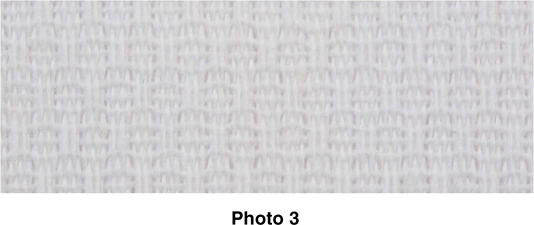
Huck toweling is about 14-count, 100 percent cotton and available only in white. It is 16 inches wide and sold by the yard. It is suggested that this fabric be washed and dried before stitching.
Traditionally used in counted cross-stitch, Aida cloth (Photo 4) works well for small to medium projects like table toppers, runners, pillows, bell pulls, bookmarks, cozies and garment insertions. Aida cloth is a basket-weave fabric that is available by the yard or precut sheets and comes in a variety of counts and colors.

Swedish weaving is generally done on 1114-count Aida cloth in either 100 percent cotton or a cotton/poly blend. It is not necessary to wash Aida cloth before stitching; it softens as it is worked.
Font size:
Interval:
Bookmark:
Similar books «Learn Swedish Weaving & Huck Embroidery»
Look at similar books to Learn Swedish Weaving & Huck Embroidery. We have selected literature similar in name and meaning in the hope of providing readers with more options to find new, interesting, not yet read works.
Discussion, reviews of the book Learn Swedish Weaving & Huck Embroidery and just readers' own opinions. Leave your comments, write what you think about the work, its meaning or the main characters. Specify what exactly you liked and what you didn't like, and why you think so.




